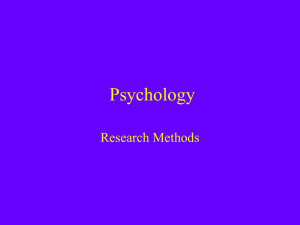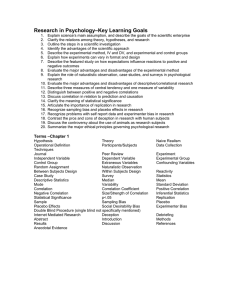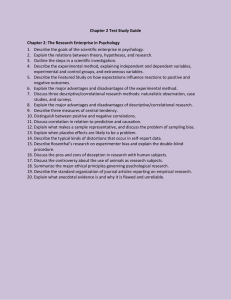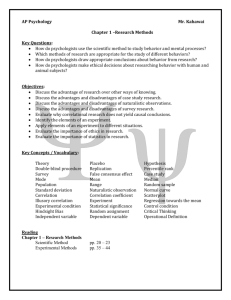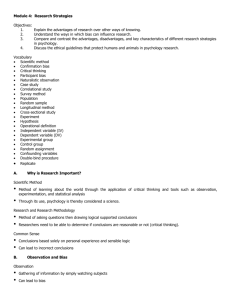Research Methods of Psychology
advertisement
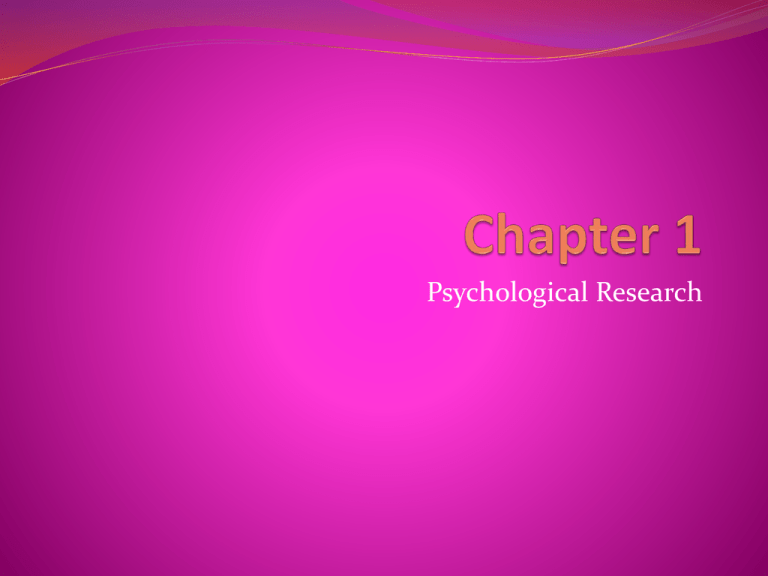
Psychological Research Take out all of your writing utensils Average/Mean for females? _____ Average/Mean for males? _____ What can we conclude from this data? Is our data scientific? The Need for Psychological Science The biases and errors of people’s everyday judgments illustrate the need for a scientific attitude: A. Skepticism Where is the evidence? How do you REALLY know this? B. Humility Scientists are willing to reject their own ideas/biases, if needed. The Need for Psychological Science C. Critical Thinking Scientists never blindly accept arguments and conclusions Four elements 1. 2. 3. 4. examine assumptions discerns hidden values evaluates evidence assess conclusions Trepanation Chipping away a hole in the skull to let out evil spirits is a cure for adolescent rebellion and the thinking that leads adolescents to behave badly. https://www.youtube.com/watch?v=YoU_-ru8yEc 1. Examine Assumptions 2. Discern Hidden Values 3. Evaluate Evidence 4. Assess Conclusions The Need for Psychological Science Critical Thinking Reduces Hindsight Bias we tend to believe, after learning an outcome, that we would have foreseen it the “I-knew-it-all-along” phenomenon Intuition Describe your intuitive moment In research, common sense (intuition) predicts what DID happen more often than what WILL happen. Intuition is based on common sense and experience! The Need for Psychological Science Overconfidence we tend to think we know more than we do Confirmation Bias our overconfidence leads us to CONFIRM our own thoughts and ignore evidence that might disprove us (bias) Have you ever ignored evidence that was contrary/different from what you believed? The Scientific Method Used to accomplish the four goals – a. Describe M.P. and beh b. Explain M.P. and beh c. Predict M.P. and beh d. Control (help) The Scientific Method Theory – organized set of principles Hypothesis – testable guess derived from theory Operational Definition How can you measure or “operate” with these variables? Test the hypothesis: Girls smile more than boys. The Need for Psychological Science Operational Definitions I want to study the effects of physical contact on attachment. I want to study the effects of sugar on attention levels. Watching television as a toddler leads to decreased ability to focus as an adult. What are the variables? How will you measure them? Six steps of the Scientific Method. a. Identify the theory b. Form an hypothesis c. Determine the variables d.Design the experiment e. Gather the data f. Analyze, conclude, and report your findings Journals, Colleagues Magazines g. Replicate = Validity Case Study Survey Naturalistic Observation Correlation Experimentation Free Response 2006 Exam Psychologists use a variety of research methods to study behavior. Three of the main research methods used are: * Case Study * Correlational Study, and * Experiment. A. Discuss the advantage of each research method listed above. B. Discuss one disadvantage of each research method listed above. Pretend you are a psychologist who will use each of the three research methods – case study, correlational study, and experiment—to determine the effect of taking Vitamin J on improving memory. C. For each method listed above, explain a key characteristic of the basic approach you could use to reach a scientific conclusion about the relationship between taking vitamin J and improving memory. You need not design a complete study. Case Study Goals Met Description (of the ONE person or ONE small group) Definition: Advantages: Intensive analysis and description of an individual or a small group. A lot of information. A rich description. Leads to ideas for future study. Case Study Continued … Disadvantages Observer Bias Difficult to generalize beyond single case studied https://www.youtube.com/watc h?v=_6Fv_P-lKYU Examples Reflection Question #3… Goals Met: Describe and Predict (if correlation determined from data) Definition: Asking predetermined questions using an interview or a questionnaire. Survey Continued … Advantages Disadvantages Lots of information Respondents might not be Relatively low cost representative (sampling bias) Respondents might not be knowledgeable or might want to please researcher (response bias) Done in a short amount of time Survey Problems …. Response Bias – What people SAY is often very different from what the DO. (Would you admit to everything you do/think/feel?) False Consensus – The tendency to overestimate the extent to which others share our beliefs and opinions. Types of Wording Effects Wording Effects – The way a question is worded affects the outcome of the survey. a. b. c. d. Emotionally Charged Questions Limited/Biased Range of Options Biased Order of the Questions Subject Ignorance Samples Provided in Class Survey/Experiment Definitions Population: Larger group you wish to generalize your findings to … the group your research will benefit. Sample of Subjects: People you choose from the population to survey (study) Representative Sample: (noun) Set of subjects that represent the population (all parts … ethnicity/sex/religion/etc.) Random Sampling: (verb/procedure) Each person in your population has an equal chance of being selected for your study. Ensures a representative sample. Examples and Reflection Question #4 Goals Met: Describe Definition: Behavior is studied in its natural environment without interference from the researcher. Naturalistic Observation Cont. Advantages: Spontaneous Not a “lab” setting Great ideas for future hypotheses Disadvantages Confirmation Bias Researcher/Observer Hawthorne Effect Subject Bias One Chance – think spontaneous moment! Reflection Question #5 Jane Goodall 60+ years of Naturalistic Observations Jane Goodall – chimps and the evolutionary value of play http://www.youtube.co m/watch?v=zvpG6lkGM Vs Goals Met: Describe and Predict Definition: Used to clarify the strength of a relationship among variables. Correlation Continued … Examples: What kind of correlation? Dark clouds and rain Study time and test scores Smoking and lifespan Consumption of hot cocoa Scatter Plots and Correlation Coefficient Direction Positive – Vary together Negative – Vary opposite None – No relationship and outside temperature Strength -1.00 < ---0.00--- >+1.00 +0.25 -0.99 +0.87 Correlation Perfect positive correlation (+1.00) No relationship (0.00) Perfect negative correlation (-1.00) Scatterplots, showing patterns of correlations Correlation Continued http://www.tylervigen.com/spurious-correlations Advantages Disadvantages Description and prediction Absolutely NO causality. are possible. Ice Cream Sales and Murder Rates Cannot explain why a relationship exists, only that there is one. Illusory Correlation (perception of correlation where none exists) Perceive a Patterns (Idaho drivers) Perceive a Random Event Fail to notice a Third Variable (shootings) (pallegra) No Cause/Cannot Explain Free Response – 2015 Exam Researchers conducted a naturalistic study of children between the ages of 5 and 7 years. The researchers visited classrooms during class party celebrations. As a measure of hyperactivity, they recorded the number of times children left their seats. The researchers found a strong positive correlation between sugary snacks offered at the parties and hyperactivity. Based on these findings, the researchers concluded that sugar causes hyperactivity. A. How might the following explain why people may easily accept the conclusion of the study described above? Confirmation bias Availability heuristic Misunderstanding of correlational studies B. As a follow-up study, the researchers are designing an experiment to test whether sugar causes hyperactivity. For the experiment, please do the following. State a possible hypothesis. Operationally define the dependent variable. Describe how random assignment can be achieved. Multi-Method Approach (Eclectic) You follow a case study closely You notice (as part of some naturalistic observations) a correlation You survey a similar set of subjects from the population You find a definite mathematical correlation You experiment to prove cause and effect Usually the last step in the research process. May include other methods along the way. Goals Met: Explain!! Definition: The investigator manipulates one or more factors called the independent variable to observe its effect on some behavior or mental process called the dependent variable while controlling other, relevant factors called confounding variables. Definitions Experimentation Independent Variable (IV): The controlled or manipulated variable. The “thing” that is given or not given to the subjects. The variable whose effect is being studied. Dependent Variable (DV): The effect (behavior or mental process) being observed that is caused by the IV. The variable that may change in response to the IV. Hypothesis and Operational Definition (see previous) Experimental Group (EG): Manipulated group Receives the treatment Receives the IV Control Group (CG): Comparison Group Does not receive the IV May receive a placebo (looks like IV, but is not have the same effect) Experimentation Continued … Random Sampling (verb) Get sample that represents (noun) the population Every KIND of person should be represented in your sample. Biased Sample Does not represent the population/can’t generalize Eliminate Researcher Bias/Subject Bias Blind – one doesn’t know Double-Blind – both don’t know Random Assignment (another verb) Randomly assign subjects to CG and EG – to make both groups representative. Experimentation Continued Example – Reflection Sheet Population IV DV CG EG Experimentation Continued … Advantages Disadvantages Conclusions can be drawn Ethical considerations – any about causation Explanations are given for behaviors and mental processes Cause and effect time you experiment with humans/animals Behavior constricted to a laboratory (not always natural/realistic) Observer Bias/Hawthorne Effect Use blind/double blind procedure to eliminate Ethical Guidelines - APA Informed consent Subject can withdraw at any time Information provided for how to contact researcher after Confidentiality Explain any misconceptions at the earliest possible time (without creating bias) 6. If deception occurs, must remove misconceptions at the end 7. Those working with animals/humans must be trained 8. Great lengths must be taken to minimize all animal/human discomfort 1. 2. 3. 4. 5.
